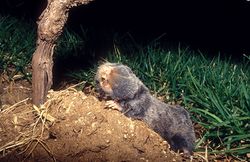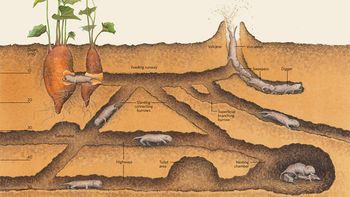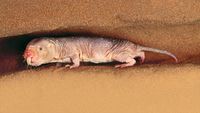جرذ الخلد الأعمى
| جرذ الخلد الأعمى | |
|---|---|

| |
| Spalax ehrenbergi | |
| التصنيف العلمي | |
| مملكة: | |
| Phylum: | |
| Class: | |
| Order: | |
| Superfamily: | |
| Family: | |
| Subfamily: | Spalacinae گراد، 1821
|
| Genus: | Spalax گولدنشتات، 1770
|
| الأنواع | |
|
Spalax arenarius | |
| Synonyms | |
|
Nannospalax Palmer, 1903 | |
جنس جرذ الخلد الأعمى Spalax أو subterranean mole rats، هو أحد أنواع القوارض والتي تسمي بجرذ الخلد[1]. rodentوجرذان الخلد هي حيوانات عمياء. تمتلك أعين صغيرة جداً مغطاة تماماً بطبقة من الجلد. وتمتلك أيدي ذات أصابع كبيرة تستخدمها في الحفر. ولأنها عمياء تماماً، تعتبر جرذان الخلد العمياء من أهم الحيوانات المعملية التي تستخدم في التجارب عن وظائف العين وبروتينات العين.
. . . . . . . . . . . . . . . . . . . . . . . . . . . . . . . . . . . . . . . . . . . . . . . . . . . . . . . . . . . . . . . . . . . . . . . . . . . . . . . . . . . . . . . . . . . . . . . . . . . . . . . . . . . . . . . . . . . . . . . . . . . . . . . . . . . . . . . . . . . . . . . . . . . . . . . . . . . . . . . . . . . . . . . .
الخصائص المميزة
حفر الأنفاق
يعد جرز الخلد الأعمى من أفضل الحيوانات الحفَّارة، فهو يحفر نفقاً بطول 13 متراً أو أكثر في الساعة الواحدة، وفي الأراضي المتشققة قد يحفر مسافة 45 متراً في الساعة. وهو يفعل ذلك بخرطومه الدقيق ودفع جسمه بطرفيه الأماميتين. وعندما يحفر نفقه يرمي التراب نحو الأعلى بشكل تلال متتابعة فوق الأرض وبفضلها يُسْتدَلُّ على ممراته.[2]
الدم
توجد أعداد كبيرة من خلايا الدم الحمراء في دماء جرذ الخلد الأعمى، كما يحمل الأكسجين داخل خلايا الدم الحمراء نسبة أكبر عنه في الثدييات الأخرى، لذلك فإنه يحتاج إلى كميات أقل من الأكسجين.[3]
الأذان
لا يمتلك جرذ الخلد الأعمى أذان، لكنه يمتلك فقط فتحان على جانبي الرأس.
العيون
لجرذ الخلد الأعمى عينان صغيرتان، وغالباً ما يستخدمهم حيث تكون أعينه مغطاة بطبقة من الجلد، ويمكنه فقط التمييز بين النور والظلام.
الأيض
لجرذ الخلد الأعمى معدلات أيض 70% ضعف القوارض الأخرى، مما يعني بطئ استخدام الأكسجين داخل أنسجته.
الأسنان
بفضل الأسنان الشبيهة بالأنياب والتي تبرز خارج الجلد، يستطيع جرذ الخلد الأعمى أثناء إغلاق شفتيه، استخدام أسنانه في حفر التربة بدون أن يتسخ فمه.
الشعور بالألم
Surprisingly, physiological studies revealed that naked mole-rat C-fibers innervating their eyes, nose, and skin do respond to capsaicin, but that the nerves do not make the neuropeptides usually released because of a defect in gene promoters associated with the pain-relaying nerve cells. While the animals express the neuropeptides in other parts of the body, such as the brain and intestines, lack of these neuropeptides from the C-fibers acts to “disconnect” the fibers from the central nervous system, preventing the feelings of pain and irritation. Sure enough, when researchers introduced one of the missing neuropeptides, Substance P, into the C-fibers of naked mole-rat feet using gene therapy, the animals licked at the injection site similarly to rats and mice.4
Insensitivity to acidic saline appears to be mediated by a different mechanism. In contrast to their response to capsaicin, C-fibers in naked mole-rats are completely unresponsive to acidic saline. A recent study revealed that acid insensitivity involves voltage-gated sodium channels, which are necessary to propagate signals along the nerve fibers.5 In naked mole-rats, these channels have a mutation that make them shut down under acidic conditions.[4]
Naked mole-rat C-fibers also have an unusual pattern of connectivity in the spinal cord. Almost half of the cells in the deep dorsal horn of the spinal cord receive direct connections from C-fibers, whereas in other species, most C-fibers terminate in the superficial dorsal horn, at the outer edge of the spinal cord. The significance of this unusual connection pattern is not clear, but it suggests that whatever signals are conveyed from the C-fibers might not follow the usual pain and irritant pathways once they reach the spinal cord.
Interestingly, naked mole-rats respond normally to pinch and heat; only C fiber-mediated pain has been muted in these animals. A greater understanding of how this type of pain processing is altered in naked mole-rats could have significant implications for the treatment of chronic pain in humans, such as post-surgical, joint and muscle, and inflammatory pain.
التصنيف
تحت فصيلة Spalacinae
- جنس Spalax – جرذ الخلد الأعلى
- Sandy Mole Rat, Spalax arenarius
- Mt. Carmel Blind Mole Rat, Spalax carmeli
- Middle East Blind Mole Rat, Spalax ehrenbergi
- Upper Galilee Mountains Blind Mole Rat, Spalax galili
- Giant Mole Rat, Spalax giganteus
- Golan Heights Blind Mole Rat, Spalax golani
- جرذ الخلد البلقان, Spalax graecus
- Judean Mountains Blind Mole Rat, Spalax judaei
- Lesser Mole Rat, Spalax leucodon
- Greater Mole Rat, Spalax microphthalmus
- Munzur Mole Rat, Spalax munzuri
- Nehring's Blind Mole Rat, Spalax nehringi
- Kazakhstan Blind Mole Rat, Spalax uralensis
- Podolsk Mole Rat, Spalax zemni
المصادر
- ^ Macdonald, D., ed. (2006). The Encyclopedia of Mammals. Oxford: Oxford University Books. p. 203. ISBN 0-87196-871-1.
- ^ حسن حلمي خاروف. "الخلد". الموسوعة العربية. Retrieved 2012-06-15.
- ^ Logan Parsons. "Digging the Underground Life". the scientist. Retrieved 2012-06-15.
- ^ Thomas J. Park and Rochelle Buffenstein. "Underground Supermodels". the scientist. Retrieved 2012-06-15.
- Jansa, S. A. and M. Weksler (2004). Phylogeny of muroid rodents: relationships within and among major lineages as determined by IRBP gene sequences. Molecular Phylogenetics and Evolution, 31:256-76. DOI:10.1016/j.ympev.2003.07.002 PMID 15019624
- Michaux, J., A. Reyes, and F. Catzeflis (2001). "Evolutionary history of the most speciose mammals: molecular phylogeny of muroid rodents." Molecular Biology and Evolution, 17:280-293.
- Musser, G. G. and M. D. Carleton (2005). "Superfamily Muroidea." pp. 894-1531 in Wilson, D. E. and D. M. Reeder, eds. Mammal Species of the World: a Taxonomic and Geographic Reference. 3rd ed. Baltimore: Johns Hopkins University Press.
- Norris, R. W., K. Y. Zhou, C. Q. Zhou, G. Yang, C. W. Kilpatrick, and R. L. Honeycutt (2004). "The phylogenetic position of the zokors (Myospalacinae) and comments on the families of muroids (Rodentia)." Molecular Phylogenetics and Evolution, 31:972-978.
- Nowak, R. M. (1999). Walker's Mammals of the World, II. London: Johns Hopkins University Press ISBN 978-0-8018-5789-8
- Steppan, S. J., R. A. Adkins, and J. Anderson (2004). Phylogeny and divergence date estimates of rapid radiations in muroid rodents based on multiple nuclear genes. Systematic Biology, 53:533–553. DOI:10.1080/10635150490468701 PMID 15371245
- Topachevskii, V. A. (1976) Fauna of the USSR. Volume III: Mammals. Issue 3: Mole rats, Spalacidae. New Delhi: Amerind.


